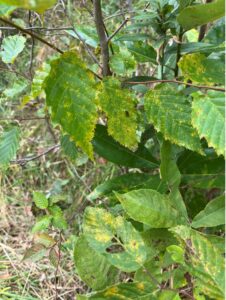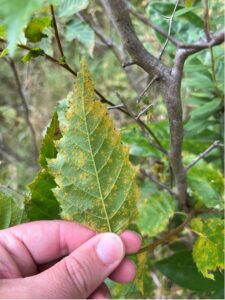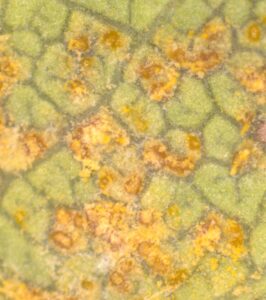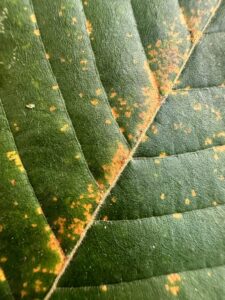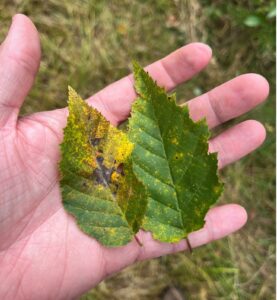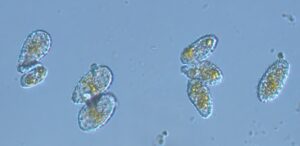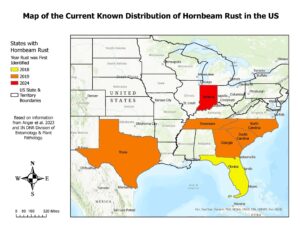During a nursery inspection in Owen County in 2024, I noticed an unusual yellowing of the leaves on some American Hornbeam (Carpinus caroliniana) trees (Fig 1). A look at the underside of the leaves revealed yellow-orange pustules, suggesting a rust fungus. After help from the Purdue Plant & Pest Diagnostic Lab, this fungal pathogen was confirmed to be hornbeam rust (Melampsoridium asiaticum), a relatively new emerging rust disease in the US.
- Figure 1: Yellowing lower leaves on a young American hornbeam caused by hornbeam rust. Photo by Willem Drews, IDNR.
- Figure 2: Underside of American hornbeam leaf with rust pustules. Photo by Willem Drews, IDNR.
Hornbeam rust can be identified by its yellow-orange raised bumps, called pustules, on the underside of the leaves of susceptible hosts (Figs 2 and 3). As these pustules develop, corresponding yellow leaf spots form on the upper side of the leaves (Fig 4). If there is a severe pustule load on the undersides, the yellowing pattern on the upper sides of the leaves may coalesce and appear as larger yellow patches (Fig 5). A highly magnified view of the rust spores is shown in Figure 6. As multiple leaves become infected the tree may exhibit yellowing in some areas and possible early defoliation. The samaras (fruit structures) may also become infected with hornbeam rust.
- Figure 3: Magnified view of American hornbeam leaf with rust pustules and rust spores. Photo by Purdue PPDL.
- Figure 4: Yellow-orange spots on upper leaf surface of rust infected American hornbeam. Photo by Willem Drews, IDNR.
Hornbeam rust originates from Japan and China and was first detected in the US in Florida in the fall of 2018. In 2019, similar rust reports were made in Georgia, South Carolina, North Carolina, Tennessee, and Texas. The new find in Owen County, IN was the first detection of Hornbeam rust in Indiana and is likely the northeastern most report in the country to date. We don’t know how this rust got to Indiana but, as with many disease and insect problems, the shipment of infected plants from other regions is a likely pathway.
- Figure 5: Rust infected American hornbeam leaves showing severely infected leaf with coalescing spots (left), and moderately infected leaf (right). Photo by Willem Drews, IDNR.
- Figure 6: Magnified spores of Melampsoridium asiaticum. Photo by Purdue PPDL.
Hornbeam rust has been documented to occur on American Hornbeam, European Hornbeam (Carpinus betulus), and Hophornbeam (Ostrya virginiana) trees. Unlike several other common rusts, such as cedar apple rust which alternates between two very different hosts (apple and redcedar), hornbeam rust appears to stay on one host throughout its life cycle.
Because of its recent discovery, not much is known about spread and control. Fungicide management in trees is usually impractical but sprays may be needed to protect young trees in the nursery or until established in the landscape. If you think you have some rust infected Carpinus or Ostrya trees, please contact a nursery inspector here, or send a sample to Purdue PPDL (information on sending samples here).
The Indiana Department of Natural Resources, Division of Entomology and Plant Pathology, publishes weekly reviews throughout the growing season written by the nursery inspectors. To receive the Weekly Review, visit: https://www.in.gov/dnr/entomology/entomology-weekly-review/
- Figure 7. Map of the current distribution of hornbeam rust in the US. Map created by Will Drews, IDNR with information from Anger et al., 2023.
